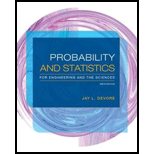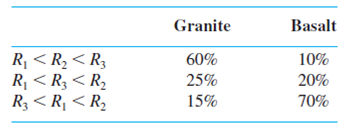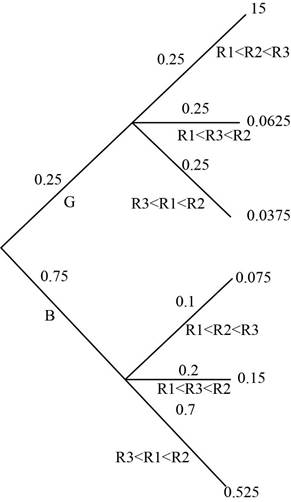
One method used to distinguish between granitic (G) and basaltic (B) rocks is to examine a portion of the infrared spectrum of the sun’s energy reflected from the rock surface. Let R1, R2, and R3 denote measured spectrum intensities at three different wavelengths; typically, for granite R1 < R2 < R3, whereas for basalt R3 < R1 < R2. When measurements are made remotely (using aircraft), various orderings of the Ris may arise whether the rock is basalt or granite. Flights over regions of known composition have yielded the following information:

Suppose that for a randomly selected rock in a certain region, P(granite) 5 .25 and P(basalt) 5 .75.
- a. Show that P(granite | R1 < R2 < R3) > P(basalt | R1 < R2 < R3). If measurements yielded R1 < R2 < R3, would you classify the rock as granite or basalt?
- b. If measurements yielded R1 < R3 < R2, how would you classify the rock? Answer the same question for R3 < R1 < R2.
- c. Using the classification rules indicated in parts (a) and (b), when selecting a rock from this region, what is the
probability of an erroneous classification? [Hint: Either G could be classified as B or B as G, and P(B) and P(G) are known.] - d. If P(granite) = p rather than .25, are there values of p (other than 1) for which one would always classify a rock as granite?
a.
Show that
Explain whether the granite or basalt is classified as rock.
Answer to Problem 106SE
It has been verified that
The rock is classified as granite.
Explanation of Solution
Given info:
The information is based on the method that helps to differentiate between the granite and basaltic rocks to examine between the infrared spectrums of the sun’s energy from the rock surface. The events
The composition of the salts is obtained in the table given below:
| Granite | Basalt | |
| 60% | 10% | |
| 25% | 20% | |
| 15% | 70% |
Calculation:
Bayles’ rule:
If
Here,
Law of total probability:
Assume that the eventsA1, A2, A3,…,Ak be mutually exclusive and exhaustive events.
For any event B,
The probability of B is obtained as:
Define the events:
The probability of the corresponding event is given below:
The probability of the granite and
The probability of the granite and
The probability of the granite and
The probability of the basalt and
The probability of the basalt and
The probability of the basalt and
Here, the probabilities of the events are represented using tree diagram given below:

By using law of total probability, the probability of the
Thus, the probability of
The probability of
Thus the
The probability of
Thus the
Hence, the probability of
b.
Explain whether the rock is classified as granite or basalt.
Answer to Problem 106SE
For both
Explanation of Solution
Calculation:
By using law of total probability, the probability of the
Thus, the probability of
The probability of
Here, the probability is less than 0.5. It is classified as basalt.
The probability of
Here, the probability is less than 0.5. It is classified as basalt.
c.
Obtain the probability of an erroneous classification.
Answer to Problem 106SE
The probability of an erroneous classification is 0.175.
Explanation of Solution
Here, G denotes granite and B denotes basalt.
The probability of the erroneous classification is obtained as shown below:
Thus, the probability of the erroneous classification is 0.1625.
d.
Identify for which value of p the rock can be classified as granite.
Answer to Problem 106SE
The rock can be classified as granite if and only if
Explanation of Solution
Calculation:
The probability of
Thus, the
The probability of
Thus, the
The probability of
Thus, the
Here,
Want to see more full solutions like this?
Chapter 2 Solutions
Probability and Statistics for Engineering and the Sciences
- 30% of all college students major in STEM (Science, Technology, Engineering, and Math). If 48 college students are randomly selected, find the probability thata. Exactly 12 of them major in STEM. b. At most 17 of them major in STEM. c. At least 12 of them major in STEM. d. Between 9 and 13 (including 9 and 13) of them major in STEM.arrow_forward7% of all Americans live in poverty. If 40 Americans are randomly selected, find the probability thata. Exactly 4 of them live in poverty. b. At most 1 of them live in poverty. c. At least 1 of them live in poverty. d. Between 2 and 9 (including 2 and 9) of them live in poverty.arrow_forward48% of all violent felons in the prison system are repeat offenders. If 40 violent felons are randomly selected, find the probability that a. Exactly 18 of them are repeat offenders. b. At most 18 of them are repeat offenders. c. At least 18 of them are repeat offenders. d. Between 17 and 21 (including 17 and 21) of them are repeat offenders.arrow_forward
- Consider an MA(6) model with θ1 = 0.5, θ2 = −25, θ3 = 0.125, θ4 = −0.0625, θ5 = 0.03125, and θ6 = −0.015625. Find a much simpler model that has nearly the same ψ-weights.arrow_forwardLet {Yt} be an AR(2) process of the special form Yt = φ2Yt − 2 + et. Use first principles to find the range of values of φ2 for which the process is stationary.arrow_forwardDescribe the important characteristics of the autocorrelation function for the following models: (a) MA(1), (b) MA(2), (c) AR(1), (d) AR(2), and (e) ARMA(1,1).arrow_forward
- « CENGAGE MINDTAP Quiz: Chapter 38 Assignment: Quiz: Chapter 38 ips Questions ra1kw08h_ch38.15m 13. 14. 15. O Which sentence has modifiers in the correct place? O a. When called, she for a medical emergency responds quickly. b. Without giving away too much of the plot, Helena described the heroine's actions in the film. O c. Nearly the snakebite victim died before the proper antitoxin was injected. . O O 16 16. O 17. 18. O 19. O 20 20. 21 21. 22. 22 DS 23. 23 24. 25. O O Oarrow_forwardQuestions ra1kw08h_ch36.14m 12. 13. 14. 15. 16. Ӧ 17. 18. 19. OS 20. Two separate sentences need Oa. two separate subjects. Ob. two dependent clauses. c. one shared subject.arrow_forwardCustomers experiencing technical difficulty with their Internet cable service may call an 800 number for technical support. It takes the technician between 30 seconds and 11 minutes to resolve the problem. The distribution of this support time follows the uniform distribution. Required: a. What are the values for a and b in minutes? Note: Do not round your intermediate calculations. Round your answers to 1 decimal place. b-1. What is the mean time to resolve the problem? b-2. What is the standard deviation of the time? c. What percent of the problems take more than 5 minutes to resolve? d. Suppose we wish to find the middle 50% of the problem-solving times. What are the end points of these two times?arrow_forward
- Exercise 6-6 (Algo) (LO6-3) The director of admissions at Kinzua University in Nova Scotia estimated the distribution of student admissions for the fall semester on the basis of past experience. Admissions Probability 1,100 0.5 1,400 0.4 1,300 0.1 Click here for the Excel Data File Required: What is the expected number of admissions for the fall semester? Compute the variance and the standard deviation of the number of admissions. Note: Round your standard deviation to 2 decimal places.arrow_forward1. Find the mean of the x-values (x-bar) and the mean of the y-values (y-bar) and write/label each here: 2. Label the second row in the table using proper notation; then, complete the table. In the fifth and sixth columns, show the 'products' of what you're multiplying, as well as the answers. X y x minus x-bar y minus y-bar (x minus x-bar)(y minus y-bar) (x minus x-bar)^2 xy 16 20 34 4-2 5 2 3. Write the sums that represents Sxx and Sxy in the table, at the bottom of their respective columns. 4. Find the slope of the Regression line: bi = (simplify your answer) 5. Find the y-intercept of the Regression line, and then write the equation of the Regression line. Show your work. Then, BOX your final answer. Express your line as "y-hat equals...arrow_forwardApply STATA commands & submit the output for each question only when indicated below i. Generate the log of birthweight and family income of children. Name these new variables Ibwght & Ifaminc. Include the output of this code. ii. Apply the command sum with the detail option to the variable faminc. Note: you should find the 25th percentile value, the 50th percentile and the 75th percentile value of faminc from the output - you will need it to answer the next question Include the output of this code. iii. iv. Use the output from part ii of this question to Generate a variable called "high_faminc" that takes a value 1 if faminc is less than or equal to the 25th percentile, it takes the value 2 if faminc is greater than 25th percentile but less than or equal to the 50th percentile, it takes the value 3 if faminc is greater than 50th percentile but less than or equal to the 75th percentile, it takes the value 4 if faminc is greater than the 75th percentile. Include the outcome of this code…arrow_forward
 Mathematics For Machine TechnologyAdvanced MathISBN:9781337798310Author:Peterson, John.Publisher:Cengage Learning,Algebra & Trigonometry with Analytic GeometryAlgebraISBN:9781133382119Author:SwokowskiPublisher:Cengage
Mathematics For Machine TechnologyAdvanced MathISBN:9781337798310Author:Peterson, John.Publisher:Cengage Learning,Algebra & Trigonometry with Analytic GeometryAlgebraISBN:9781133382119Author:SwokowskiPublisher:Cengage Trigonometry (MindTap Course List)TrigonometryISBN:9781337278461Author:Ron LarsonPublisher:Cengage Learning
Trigonometry (MindTap Course List)TrigonometryISBN:9781337278461Author:Ron LarsonPublisher:Cengage Learning


